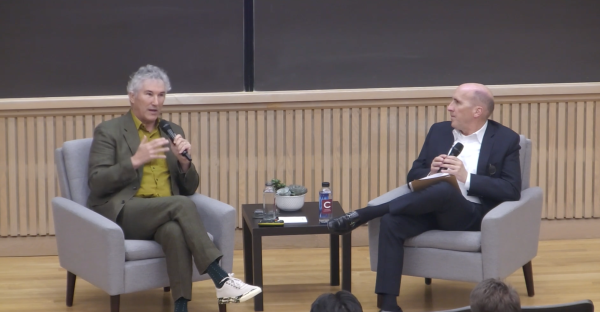Summer Snail Study Amazing Experience For Geology Major
When you meet junior Jason Kaplan, you may be struck by what he describes as his “out-of-control Jewfro” and his sense of humor. You might think that it makes sense that he would be the President of the Colgate Jewish Union or be a member of Charred Goosebeak. Even his time spent giving tours for the Admissions Office, creating and starring in commercials for CUTV and acting and singing in the musical “Joseph” last semester make sense. It is all one big performance.
But snail research? It just does not seem to fit.
“During my first two years at Colgate, I heard students talk about doing research with their professors and I thought that would be really cool,” Kaplan said.
But Kaplan was worried that he would not meet the standards.
“Doing research is a prestigious opportunity,” he said. “I was unsure that I could live up to those expectations, but I surely didn’t want to spend a second summer working in an eyeglass storage warehouse.”
During the spring of 2004, while enrolled in Harold Orville Whitnall Professor of Geology Bruce Selleck’s Hydrology class, Kaplan took matters into his own hands.
“During the middle of the semester, I just walked into Bruce’s office and said, ‘Bruce, I would really like to do research this summer. Do you have any projects I could work on?’ And surprisingly, he said, ‘Yes, Jason. As a matter of fact I do.'”
When Selleck explained the research to Kaplan, which involved utilizing the stable isotope values found in the snail shells and determining the environment in which the carbonate was precipitated, Kaplan was excited to get started.
On July 19, Kaplan arrived at Colgate, eager to get started.
“I was a little apprehensive about staying at Colgate this summer because I could only imagine it being a complete ghost town,” Kaplan said. “I was completely wrong.”
“Summers at Colgate are amazing,” Kaplan said. “Geology is a department that has a lot of students doing research, so I always had people to get lunch with, go to the movies with and party with. I had such an awesome time here this summer; I wouldn’t be surprised if I was back next summer doing more research.”
But enjoyable times at the Tap Room were not even the highlight.
“My favorite part of the research was the actual collecting of snails,” Kaplan said.
He collected his samples at Woodman Pond, a wilderness preserve that is two miles north of Colgate. For the first two weeks, Kaplan would bike to the pond and wade in the water.
“I would walk into the water to my waist with my trusty net and search for snails,” he said.
Senior Lecturer in Geology Dianne Keller commended Kaplan on his summer work.
“Jason has an intellectual curiosity – he’s interested, thoughtful and asks questions,” she said. “He also had the ability to steel himself against the ‘joys’ of walking through muck and seaweed and pulling snail carcasses out of shells.”
Kaplan collected approximately 30 Viviparus georgianus, commonly known as the banded mystery snails, during those first weeks. But then what happened?
“I would bring these snails back to Lathrop and do the dirty work,” Kaplan said.
This dirty work involved Kaplan boiling the snails he caught in water. After pulling out the physical snail, he would put the shell into a 50/50 solution of bleach and water to kill off any organic material on the shell and clean it. Then, he would look at each snail under a microscope and try to find every growth ring.
“I would cut each snail shell into its annual growth rings, grind them to a powder, cook them in an oven and put them in vials,” Kaplan said. “I sent all my samples to SUNY Albany, where they could be tested.”
Kaplan attributes great value to the hands-on experience he gained over the summer.
“You can learn about isotopes and snails by reading a variety of books and journal articles, but what I gained over this summer was more of an understanding,” Kaplan said. “I gain so much more knowledge when I am engulfed in the material.”
Keller agreed.
“Students seem to really enjoy learning the various hands-on techniques and using a wide variety of analytical instrumentation,” she said, “although they are often surprised by the amount of work that is involved with collecting the necessary data.”
Kaplan not only broadened his intellectual and educational horizons, but made some new friends in the process.
“The friendships I made with the professors in the department are priceless,” Kaplan said. “The times spent getting to know the Geology professors personally this summer, either hanging out at the Tap room or chowing down on Professor of Geology Art Goldstein’s famous ribs, are unforgettable.”
Ironically, Kaplan originally wanted to be an economics major and perhaps dabble in the political science department.
“Geology or any science that had any labs was the furthest from my mind,” Kaplan said.
But during his first year at Colgate, Kaplan took Introduction to Oceanography with Paul Pinet.
“I became a Geology major because of Paul,” Kaplan said. “The class completely changed my idea of what I wanted to study.”
After taking several other geology classes and getting to know all the professors in the department, it became very clear that Lathrop Hall would be Kaplan’s new home.
Now Kaplan is a Geology major and a Jewish Studies minor.After Kaplan graduates from Colgate, he would like to go to law school and become an environmental lawyer, a consultant or draft environmental legislation.
“There are many issues that I feel strongly about, mostly dealing with hydrology,” he said. “I have found a great interest in the way Americans use or abuse the natural resource that is water. If I could quote C.W. Fetter, in Applied Hydrogeology, ‘Water is the elixir of life; without it life is not possible.'”




